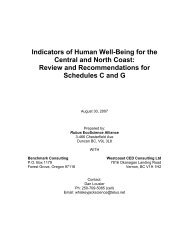Final report - Integrated Land Management Bureau
Final report - Integrated Land Management Bureau
Final report - Integrated Land Management Bureau
You also want an ePaper? Increase the reach of your titles
YUMPU automatically turns print PDFs into web optimized ePapers that Google loves.
Source: Statistics Canada, Census 2006.<br />
Transportation Assessment of the Central & North Coast of BC<br />
TABLE 2-6: ABORIGINAL AND NON-ABORIGINAL INCOME STATISTICS FOR CENTRAL AND NORTH<br />
COAST, 2005<br />
Labour Force<br />
Average<br />
Annual<br />
Earnings*<br />
Unemployment<br />
Rate<br />
Labour Force<br />
Participation<br />
Rate<br />
% of Govt<br />
Transfers in<br />
Income<br />
Prince Rupert Aboriginal $19,643 23.2% 61.30% 29.3%<br />
Prince Rupert Non-Aboriginal $36,214 8.8% 71.60% 11.5%<br />
Prince Rupert Overall $31,481 12.9% 68.30% 14.7%<br />
Kitkatla $9,710 60.0% 46.30% 54.1%<br />
Bella Bella $16,243 20.3% 47.10% 27.2%<br />
Klemtu $14,816 26.3% 45.20% 27.1%<br />
* For people with positive earnings.<br />
While the economic status of Prince Rupert Aboriginal residents is slightly better<br />
than in the outlying First Nations communities, as a group they are economically<br />
much worse off than the city’s non-Aboriginal population. For example, the<br />
Aboriginal unemployment rate in Prince Rupert is 2½ times higher than the<br />
unemployment rate of the non-Aboriginal labour force. In Kitkatla, the<br />
unemployment rate is much higher, 60%. The average income of Aboriginal labour<br />
force participants of Prince Rupert is about one-half that of the income level of<br />
the city’s non-Aboriginal labour force, while the average income in Kitkatla, Bella<br />
Bella and Klemtu is much lower. There is no doubt that proximity to employment<br />
opportunities in an urban centre like Prince Rupert translates to higher income<br />
levels. Nevetheless, Aboriginal residents are not yet fully realizing these benefits.<br />
The unemployment rate is also extremely high in Aboriginal communities of the<br />
LRMP Plan area, ranging from 20.3% in Bella Bella to 60% in Kitkatla in the shown<br />
table, while the labour force participation rates are correspondingly low. The<br />
forestry and wood processing sectors have been neither steady nor significant<br />
sources of employment for Central and North Coast First Nations, although<br />
resources do form the basis for some employment in most or all of the<br />
communities. The tourism sector, where more entry level positions are available<br />
than in many other sectors, has also been a weak source of employment for<br />
Aboriginal persons. The public sector (specifically health and education jobs) is a<br />
major employer in most of the communities of the LRMP Plan area.<br />
Chisholm Consulting 11

















